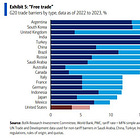The trade war in context
Why the stakes are so high, and why any America-China deals will be narrow, limited, and temporary.
Trump is attempting to reconfigure global defence and trade to improve America’s geopolitical position. It is worth recalling where we are, to understand what is driving the Trump administration.
Reckless Western foreign policy drove together China, Russia, and Iran, creating an industry and natural resource behemoth.
Free trade, Chinese IP theft, sanctions on Russian energy, and zealous net zero policies caused Western manufacturing to collapse. As such, resource-rich developing countries became far more reliant on China, their new primary trade partner, than on the West.
China has used this to develop fully integrated minerals supply chains, giving it a dominant role in rear earth minerals and most mineral production, with Chinese firms controlling everything from mining through smelting all the way to manufacturing advanced products.
The West, in turn, became reliant on China for critical electronics components, minerals, steel, manufactured goods, pharmaceuticals, and much more.
All the while, Western societies - America’s main allies - insist on imposing woke extremism on their judiciary, police, military, and parliaments, preventing them from even seeing these challenges, let alone rising up to them.
Trump sees these problems. He articulates them poorly, partly, and combatively.
Trump’s aims
To address these problems, the Trump administration is pursuing myriad policies simultaneously, with a view towards gaining as many quick victories as possible. This, combined with Trump’s personal style and a hostile media, creates the impression of chaos, when the core aim is self-evident: unifying the West against China.
The key objectives, as well as the outcomes of success and failure, are as follows:
Build up the American economy:
Success:
Deregulation, lower taxes, more automation, increased domestic investment, greater labour force participation.
Control over key parts of the establishment - including both academic institutions and the civil service - to prevent backsliding.
Failure
Trump administration policies are temporary and easy to reverse.
Continuously hostile rival establishment in the universities, media, and civil service.
Break up the China-centred alliance:
Success
Deals with Russia and Iran, allowing the US, EU, Japan, and South Korea to trade with them freely, and giving them options other than China.
Russia becomes part of the containment strategy targeting China, working closely with Japan, Vietnam, India, and South Korea. The US can then take a backseat role.
Iran’s nuclear programme is at least heavily curtailed, and its government turns away from the Islamic Revolution.
Energy prices come down due to new deals with Russia and Iran.
Failure:
Russia, Iran, and Central Asia become Chinese vassals.
This China-led alliance expands, and southeast Asia accepts Chinese hegemony.
Consolidate control over Western Europe and Latin America, using trade and defence as levers.
Success:
The current European elites are removed, resulting in changed European policies over DEI, net zero, free speech, defence, welfare, immigration, and other arenas.
Europe becomes a more effective partner, rather than a vassal with strong views.
Latin American trade with the US increases, feeding renewed American manufacturing.
Failure:
the EU continues its strategic drift, curtails freedoms further, and is increasingly weakened and destabilised by Islamic migration.
America turns autarkic, fails in reactivating the Monroe Doctrine, and risks Anglo-Hispanic conflict on its soil.
Consolidate over North America.
Success:
On one extreme of the success spectrum, Canada abandons all net zero, open door migration, and DEI policies, imposes trade and investment restrictions on China fully aligned with the US, and opens up more territory to natural resource exploration in partnership with American companies. It also invests in its navy, and fully integrates it with the US. On the other extreme, Canada is officially annexed.
America acquires or invades Greenland, or, at the very least, dramatically increases its investments and basing rights there.
America’s role in the Arctic, including in shipping, defence, and extractive industries, expands considerably.
Failure:
Canada appeases the US half-heartedly on some measures, but continues with its strategic balancing between America and China.
Greenland’s status quo remains.
Reconfigure trade.
Success:
China is cut off from the EU and the US in high tech sectors, EVs, AI, and many others, to counter its advantage in labour costs, its IP theft, and its subsidies.
An EU - Anglosphere - Japan free trade zone emerges, free from tariff and non-tariff barriers. Latin America is given favourable access in some areas, as are South Korea, Iran, and Russia.
The WTO and the assumptions around free trade are over.
Failure:
China becomes the global hegemon within two decades, despite its fertility problem, having overtaken the US and therefore all other players in defence production.
More countries join China in bilateral trade agreements.
Japan-China competition and proxy conflicts escalate.
Commercial Implications
The China-US trade war is an existential aspect of their competition over global hegemony. As such, while we anticipate limited transactional deals, we do not expect a new stable trading arrangement between the West - led by America - and China.








